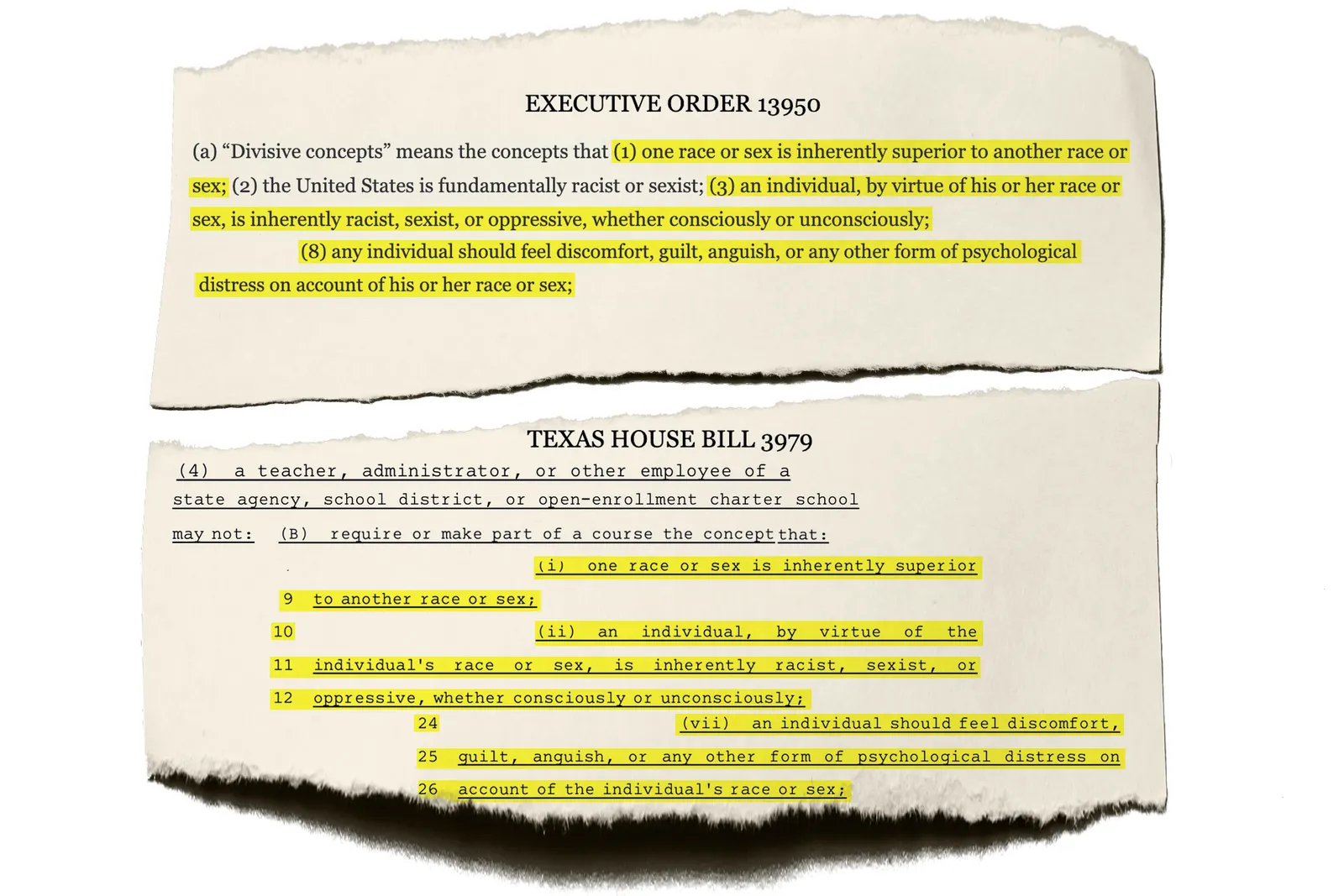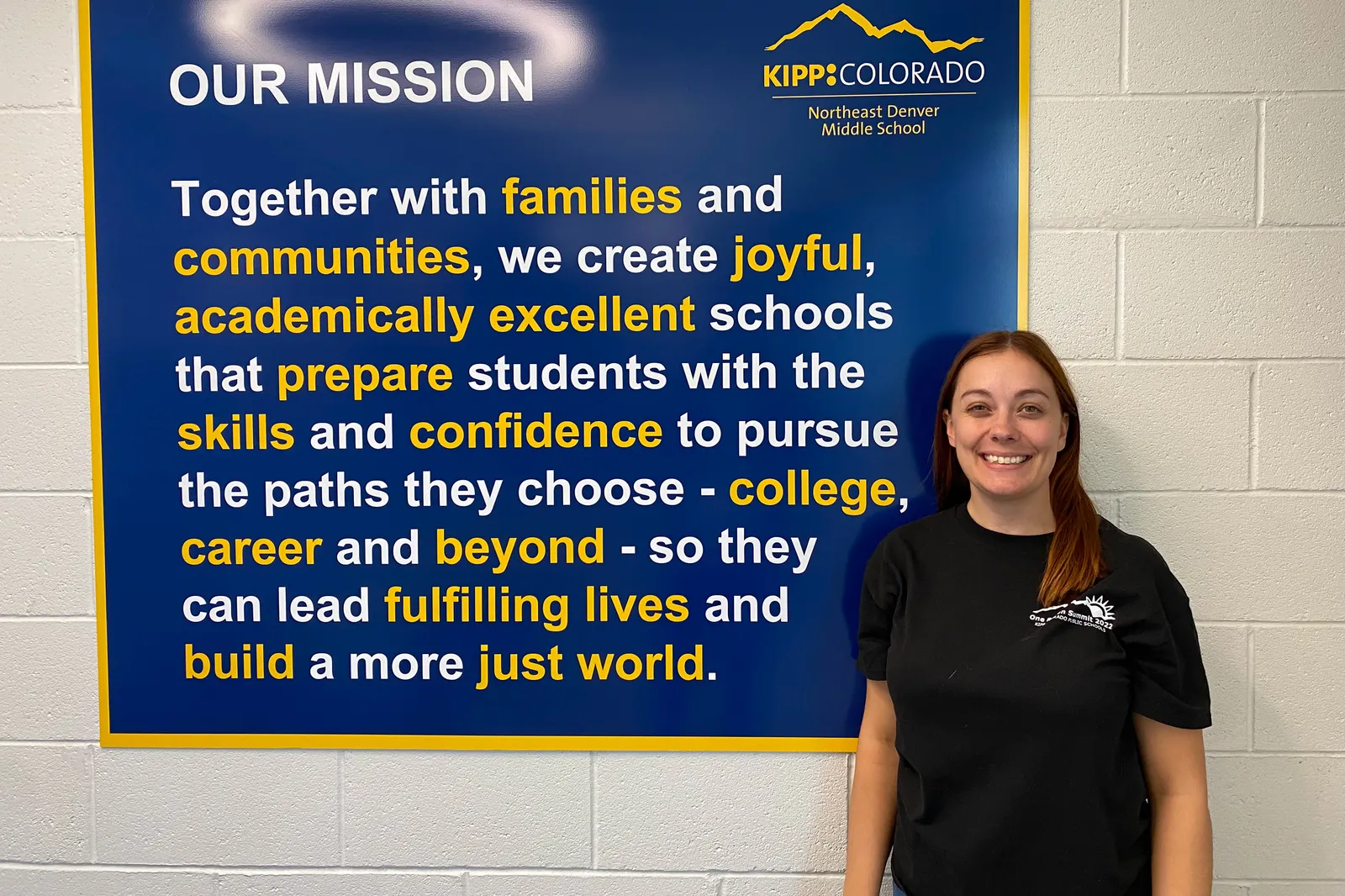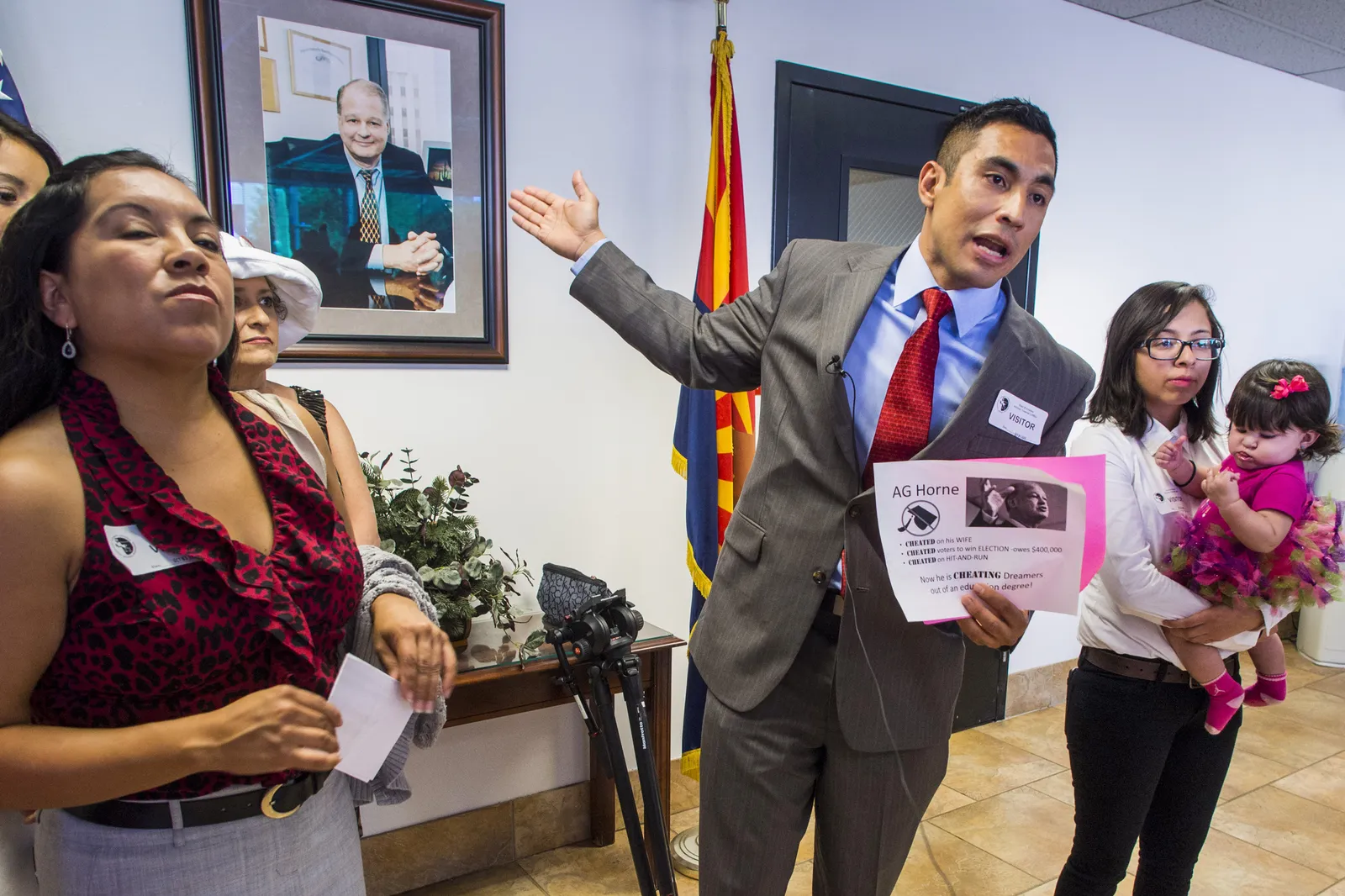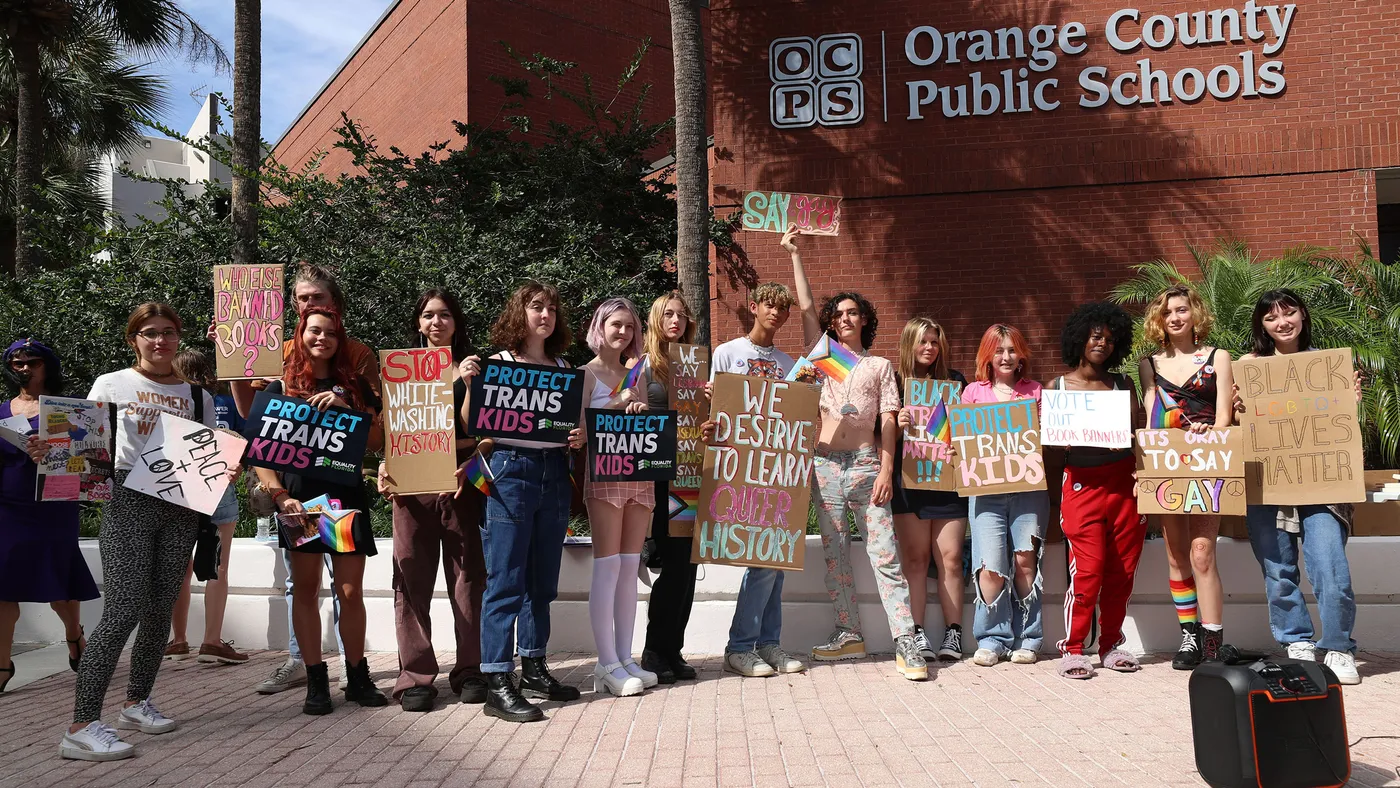This article is the first installment of Star-Spangled Bans, a series examining the history and ongoing impacts of policies seeking to censor classroom discussions. For the full series, click here.
When a White man was charged with shooting and killing 10 Black people in a supermarket in Buffalo, New York, last May, news of the massacre reverberated around the nation. Sorrow, rage and frustration at yet another mass shooting — this one seemingly racially motivated — crept into work meetings, religious gatherings and dinner table conversations. Yet many classrooms remained silent.
"We had a week and a half left of school, and we were given very specific instructions not to talk about it, not to bring it up," said Katrina Henning, at the time a 5th grade social studies and English teacher at a Florida school. "Not to even mention it."
This wasn't the first time Henning had to censor parts of her teaching.
Earlier that year, she said, administrators quietly instructed Henning and her colleagues to replace social studies with reading instruction after Florida's state board of education banned teaching of critical race theory. Additional state laws restricting discussion on gender and sexuality further complicated her job. Since then, she has trimmed texts about Alexander the Great, removed Pride flag stickers from classrooms, and skirted around conversations on Russia's invasion of Ukraine.
"I was just terrified my boss was gonna walk in," Henning said. "And that I was gonna lose my job."
42 state legislatures introduced classroom censorship bills
Classroom censorship spreads post-Trump
Many educators across the nation are teaching around laws similar to Florida's. Anti-CRT laws, parental rights laws sometimes known as "Don't Say Gay," book bans and other classroom censorship bills have been passed in at least 15 states, placing restrictions on topics like race, gender, sexuality and U.S. history. Many schools kicked off the 2022-23 school year with new expectations under these types of laws passed in the last year.
So far this calendar year, 137 such bills in K-12 and higher education were introduced across 36 states, according to PEN America, a free speech and human rights nonprofit organization. That's a whopping 250% increase from 2021.
Increasingly, lawmakers are attaching punitive measures to these bills, said Jeremy Young, who has been tracking the issue as senior manager of free expression and education at PEN America. These include heavy fines or loss of state funding for schools, as well as termination, loss of licenses or even criminal charges for teachers.
In Virginia, Gov. Glenn Youngkin launched a teacher tip line meant to out educators teaching banned topics, such as ones related to systemic racism or current and historical inequality. The New Hampshire Department of Education launched a webpage for reporting alleged discrimination after its legislature passed a law restricting discussion on race, sex, gender, social status and oppression.

The explosion of education censorship laws — and even the language used in some of them — can be traced largely back to executive orders from then-President Donald Trump.
In September 2020, Trump issued an executive order prohibiting federal workplace trainings from covering "divisive concepts," including teaching that "the United States is fundamentally racist or sexist" or that people are "inherently racist, sexist, or oppressive, whether consciously or unconsciously" as a result of their race or gender. That order was blocked nationwide three months later by a federal judge who said it violated free speech.
The New Hampshire classroom law "is virtually identical to the Trump executive order," said Gilles Bissonnette, legal director of the ACLU in the state.
A separate order issued by Trump in November 2020 described race-related American history in public schools as "one-sided" and a "radicalized view of American history [that] lacks perspective" and makes students believe "men and women who built [the nation] were not heroes, but rather villains."
Two years later, the fallout from those orders — and the slew of state laws they spurred — have drastically shifted school cultures and climates at all levels of the education system.
15 states pass classroom censorship laws since 2021

Katrina Henning, the English and social studies teacher from Florida, planned to leave the profession after the 2021-22 school year.
"I told several friends that I was very adamant I'm not going back into the classroom," Henning said. "I would rather wait tables than have to be in this environment again."
Censorship laws in the state, she said, were "the final nail in the coffin" after COVID-19.
Henning is not alone. According to a poll released in July by the American Federation of Teachers, the nation's second-largest teacher union, job dissatisfaction among pre-K-12 educators has risen 34 percentage points, from 45% to 79%. Nearly 90% of respondents said schools have become too politicized.
It was only a LinkedIn message from a charter school in Denver that kept Henning in the profession. Her new school has a focus on equity and social justice, and its leaders wanted her in their classroom. "And that's why I chose to move out here."
Meanwhile, about 70 miles south in Colorado Springs, 5th grade teacher Angelica Givler was dealing with opposition from her community for her educational equity work — despite Colorado not having anti-CRT or anti-LGBTQ education laws on the books.
Not even hours from where Henning's new school welcomed social justice work, Givler was busy speaking at school board meetings to challenge community members rallying against social-emotional learning and LGBTQ inclusion, among other things.
"And so over the last year, I have become subject to attacks from the general public," said Givler, who holds a Ph.D. in education. Among the names she's been called are "groomer" and "indoctrinator."
Online right-leaning activist groups have called for her to be fired. One community member, who doesn't even have children in the district, angrily called the school's office to report her, Givler said.
The events unfolding there are not uncommon even for districts in states without censorship laws. Many districts, just towns apart, are dealing with starkly different environments depending on their community's politics.
Teachers in states with censorship laws or in locations with a strong right-leaning presence report feeling harassed, mistrusted and in some cases targeted. Throughout K-12 Dive's reporting on the subject, many refused to speak for fear of backlash or only agreed to speak on the condition of anonymity.
Educators in districts with censorship laws who agreed to speak on the record, as well as those who wouldn't, reported feeling compelled to suppress conversations around history, race, gender and sometimes religion in their classrooms. They said they felt unable to fully support and protect their students or their identities.
The result, they say, is a culture of fear and ideological division that drives them out of specific schools or the teaching profession entirely.
In a RAND survey released this year, over a third of teachers and 61% of principals reported being harassed for, among other things, teaching about race, racism or bias during the first half of the 2021-22 school year.
"We'd been hailed as heroes … during lockdowns and that first year of COVID," said Givler. "And then all of a sudden, it just flopped last year, significantly.”

‘We fought this fight before’
But a panoramic view backward suggests a more gradual shift than today's educators are expressing.
"There certainly have been periods in history where we fought this fight before," said Megan Fromm, education manager for the National Association for Media Literacy Education.
Social studies and media literacy experts point to examples like resistance to teaching evolution that led to litigation — most notably the landmark Scopes case of 1925, the anti-gay and lesbian movements of the 1970s, book banning efforts in the 1980s, and local moves to remove culturally inclusive curriculum as recent as during the 2000s. All of these, they say, stand as precursors to the recent spate of classroom censorship policies.
In Arizona, professor Sybil Durand says, the current anti-CRT legislation is reminiscent of a program banned in 2010 by then-Gov. Jan Brewer on Mexican American studies. That program was meant to close a historic achievement gap and help Tucson Unified School District's Mexican-American students see themselves in their studies.
By threatening a penalty of 10% of a district's monthly portion of state funding, the ban prevented classes that “promote resentment toward a race or class of people,” are “designed primarily for pupils of a particular ethnic group," or “advocate for ethnic solidarity instead of the treatment of students as individuals.”
That prohibition affected not only teachers in Tucson, but classrooms more broadly across the state, said Durand, who is an associate professor of teaching, learning and sociocultural studies at University of Arizona's College of Education. Districts statewide begin to take books off shelves and adjust curriculum in response to the law, Durand said.
Seven years later, a federal judge struck down the ban as unconstitutional, saying lawmakers were "pursuing these discriminatory ends in order to make political gains."
Indeed, after the law's signing in 2010, Arizona Republican state lawmaker John Huppenthal — who at the time posted on political blogs this message under a pseudonym: "No Spanish radio stations, no Spanish billboards, no Spanish TV stations, no Spanish newspapers. This is America, speak English."— won the seat of Arizona superintendent of public instruction. Tom Horne, the other Republican lawmaker who campaigned for the ban and was singled out in the lawsuit alongside Huppenthal, is now running for Arizona Superintendent of Public Instruction. At publication time, the race was still too close to call.
Huppenthal and Horne's successful drive to enact legislation prohibiting Mexican-American studies is strikingly similar to efforts a decade later in states that have passed anti-CRT and anti-LGBTQ bans.
These are "political issues that these politicians have realized are a very effective way to rile up their base" said Michael Bronski, Harvard professor of the practice in media and activism in Studies of Women, Gender, and Sexuality. Bronski's research covers LGBT history and culture.
Multiple experts in social studies fields have described the push to ban race-related and LGBTQ issues as a "moral panic" in response to increasing LGBTQ visibility and awareness, the Obama presidency and the Black Lives Matter movement.
And one of the immediate ways to tame that panic into activism and change is through local elections, those familiar with the issue said.
"For a lot of people, the logical or perhaps most impactful way to do that is within a school setting. It's school boards," said Fromm, of the National Association for Media Literacy Education. "They represent — for a lot of communities — a ground zero of where they can impact change."
The result is both a localized movement driven by parents and a larger scale movement coordinated by politicians and organizations to replicate that mobilization nationwide.

A critical cog in that wheel: book bans. Even in states where anti-CRT and anti-LGBTQ legislation has not been enacted, local boards are taking it upon themselves to remove books from shelves that have been written by or are about people of color and LGBTQ individuals.
“The trends are very clear that this is a targeted effort," said Jonathan Friedman, report author and PEN America’s director of free expression and education programs. "These are not just individual complaints about books that parents are complaining about because their children are bringing them home."
Where librarians and teachers traditionally dealt with parent pushback against books that made them uncomfortable for their own children, pockets of parents and organizations are now pushing to ban literature and prevent access for all students.
“Parents and community members play an important role in shaping what students learn in school,” said Suzanne Nossel, CEO of PEN America, “but this goes far beyond organic expressions of concern or the normal give-and-take between parents and educators in a healthy school environment."
The pace at which this cog is turning is striking to those who have studied the issue.
PEN America, which has closely tracked the trend, has documented more than 2,500 book bans in nearly 140 school districts affecting over 4 million students across 32 states during the 2021-22 school year alone. That count includes 1,648 unique titles.
Within just a nine month period from July 2021 to March 2022, the organization counted 1,586 book bans. That effort has leaked into the 2022-23 school year, with at least 139 additional bans taking effect between July 2022 and when the report was published in September.
A vast majority — 96% — of those books have been banned without any established neutral process that is usually required to evaluate whether a book is fit for students.
A typical reconsideration process usually involves parents reading the material, discussing concerns with the school directly and then filling out forms for reconsideration of whether the book should stay on the shelf or be removed, according to Kathy Lester, a school librarian at East Middle School in Plymouth, Michigan, and president of the American Association of School Librarians.
A reconsideration committee with representation from students, teachers, and administrators who also read the book in question then vote on whether it should be removed, Lester said.
The pace and way in which books are being banned, however, suggests this process isn't being followed, said Nadine Johnson, an attorney and managing director at PEN America.
Instead, organizations and parents are sometimes submitting a list of hundreds of books at a time. One Texas district, for example, received requests from about 10 people to reconsider 120 books within the span of two months from a list compiled by right-leaning group Moms For Liberty. Such lists are sometimes copied and pasted — with typos — from one complaint against a district to the next.
In some cases, teachers and librarians report books being taken off the shelves and curricula being changed quietly and even preemptively in what's called "soft censorship."
"I heard one school librarian where her administrator just came and said he wanted to borrow something," Lester said. "And then he just never returned it. And it was his way of essentially keeping it out of the library."
A comprehensive list of more than 2,500 books compiled by PEN America shows bans on classic books, top contemporary sellers, and autobiographical works. Included in the list are books on Jim Crow, mass incarceration, immigration and different cultures, Roe v. Wade, being LGBTQ+ in America, American protest movements of the 1960s, and notable figures like Jackie Robinson, Malala Yousafzai, Michelle Obama and former President Barack Obama.
Tiffany Justice, co-founder of Moms For Liberty, an organization that has advocated for removing from schools and libraries certain books related to race, gender or sexual orientation, said her group opposes "pornographic" materials in school texts available to children.
Justice also said Moms for Liberty opposes teachers discussing social justice issues in the classroom. "Teachers shouldn't be teaching religion in school, and 'woke' is a religion," Justice said.
As such, the organization supports laws to limit classroom discussion in areas related to racial, gender and sexual identities. According to Justice, discussions on race and racism deepen pre-existing racial divides. She also said topics outside of teaching standards, such as LGBTQ issues, take away from time spent on standardized areas of student achievement like reading proficiency.
What kinds of stories are being banned?
‘They found a lot of solace in books’
This is despite evidence that LGBTQ youth and students of color who traditionally have experienced isolation show higher levels of engagement when they see themselves in their curriculum or have access to culturally reflective resources. Research compiled by New America shows that portraying various social identities in education materials has a positive impact on how and what students learn, according to a review conducted by a public policy think tank of over 160 studies on the topic.
"To get students to really engage with the material, it has to be worthwhile, it has to be interesting, it has to be relevant to their lives," said Durand, whose own research looks at how teachers and students of color engage with representation of youth of color in literature.
Yet access to LGBTQ+-related books and resources in school libraries decreased in 2021 when compared to 2019, according to a GLSEN survey of LGBTQ youth released in October. Being taught positive LGBTQ+ material in class has been one of the least common curricular supports, changed little across prior survey years, and was also lower in 2021 than in 2019, the survey showed. GLSEN is a nonprofit that advocates for inclusive public schools for LGBTQ students.
Darnell Sampson, executive director of student support teams in Virginia’s Alexandria City Public Schools, says his research on transgender students' qualitative experiences shows they value representation in books.
"They found a lot of solace in books … books that had kids like them — that were transgender, or nonbinary — or even books that were just broadly about difference really meant a great deal to them," Sampson said.
Another survey, conducted by The Trevor Project, shows access to inclusive media and learning about LGBTQ history among sources of joy for LGBTQ students.
"Conversely, then, if we have situations where we're taking books about people who are like them … then we're taking away that resource, and we're taking away an opportunity for a student to maybe not feel so alone or [making them] feel like other people don't understand," Sampson said.
Durand questions who these bans, often invoked in the name of preserving children's innocence, are meant to protect.
"Which children are we talking about? Because young people also face adversity and face racism and face sexism and adultism [the power adults have over children]," Durand said. "And for those who are already experiencing these things, what are we actually doing to protect them?”














